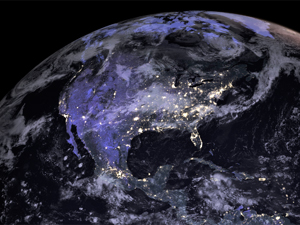



Date:05/04/19
 Amazon is entering the satellite-broadband race. It will launch 3,236 satellites in low Earth orbit to bring high-speed, affordable internet across the world.
Amazon is entering the satellite-broadband race. It will launch 3,236 satellites in low Earth orbit to bring high-speed, affordable internet across the world.
The Amazon effort, codenamed Project Kuiper, first became public through regulatory filings with the International Telecommunications Union. According to GeekWire, which spotted the filings, Amazon wants the satellites to operate between 367 miles to 391 miles above the Earth. Together, they'll beam internet service from an area between latitude 56 degrees north (the Alaskan penisula) to 56 degrees south, or about where 95 percent of the world's population lives.
"This is a long-term project that envisions serving tens of millions of people who lack basic access to broadband internet," an Amazon spokesperson told PCMag. "We look forward to partnering on this initiative with companies that share this common vision."
Amazon declined to get into specifics, like when the broadband system will actually arrive, speeds, and how much it'll cost consumers. The company only said it'll be years before the service is available.
Although satellite-powered broadband is nothing new, a number of companies want to upgrade existing offerings with next-generation low-Earth orbit satellites that can provide faster speeds and lower latency.
Elon Musk's SpaceX is aiming for a system that can deliver up 1Gbps speeds via a network of 12,000 satellites, with the latency ranging between 25 to 35 miliseconds on par with ground-based services. It launched a pair of demo satellites last year.
Another player is Telesat, which is partnering with Alphabet's Loon, to launch a next-generation satellite-powered broadband service in 2022.
Amazon's own effort will likely leverage rockets from Blue Origin, an aerospace company founded by Amazon CEO Jeff Bezos. Last year, Amazon's cloud service, AWS, was also in search of a"space and satellite" system engineer.
Amazon likely named its broadband effort after the Kuiper belt, an area on the edge of our solar system, consisting of a disc of asteroids and ice objects. It's named after Dutch-American astronomer Gerard Kuiper.
Amazon Plans to Offer Satellite-Powered Internet
 Amazon is entering the satellite-broadband race. It will launch 3,236 satellites in low Earth orbit to bring high-speed, affordable internet across the world.
Amazon is entering the satellite-broadband race. It will launch 3,236 satellites in low Earth orbit to bring high-speed, affordable internet across the world.The Amazon effort, codenamed Project Kuiper, first became public through regulatory filings with the International Telecommunications Union. According to GeekWire, which spotted the filings, Amazon wants the satellites to operate between 367 miles to 391 miles above the Earth. Together, they'll beam internet service from an area between latitude 56 degrees north (the Alaskan penisula) to 56 degrees south, or about where 95 percent of the world's population lives.
"This is a long-term project that envisions serving tens of millions of people who lack basic access to broadband internet," an Amazon spokesperson told PCMag. "We look forward to partnering on this initiative with companies that share this common vision."
Amazon declined to get into specifics, like when the broadband system will actually arrive, speeds, and how much it'll cost consumers. The company only said it'll be years before the service is available.
Although satellite-powered broadband is nothing new, a number of companies want to upgrade existing offerings with next-generation low-Earth orbit satellites that can provide faster speeds and lower latency.
Elon Musk's SpaceX is aiming for a system that can deliver up 1Gbps speeds via a network of 12,000 satellites, with the latency ranging between 25 to 35 miliseconds on par with ground-based services. It launched a pair of demo satellites last year.
Another player is Telesat, which is partnering with Alphabet's Loon, to launch a next-generation satellite-powered broadband service in 2022.
Amazon's own effort will likely leverage rockets from Blue Origin, an aerospace company founded by Amazon CEO Jeff Bezos. Last year, Amazon's cloud service, AWS, was also in search of a"space and satellite" system engineer.
Amazon likely named its broadband effort after the Kuiper belt, an area on the edge of our solar system, consisting of a disc of asteroids and ice objects. It's named after Dutch-American astronomer Gerard Kuiper.
Views: 416
©ictnews.az. All rights reserved.Similar news
- Azerbaijani project to monitor disease via mobile phones
- Innovative educational system to be improved under presidential decree
- NTRC prolongs license of two TV and radio organizations for 6 years
- Azerbaijan establishes e-registry for medicines
- Azerbaijani museum introduces e-guide
- Nar Mobile opens “Nar Dunyasi” sales and service center in Siyazan city
- International conference on custom electronic services held in Baku
- OIC secretary general to attend COMSTECH meeting in Baku
- Azerbaijan develops earthquake warning system
- New law to regulate transition to digital broadcasting in Azerbaijan
- Azerbaijani State Social Protection Fund introduces electronic digital signature
- Intellectual traffic management system in Baku to be commissioned in December
- Tax Ministry of Azerbaijan started receiving video-addresses
- World Bank recommends Azerbaijan to speed up e-service introduction in real estate
- Azerbaijan to shift to electronic registration of real estate





















